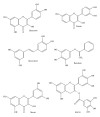Polyphenols: multipotent therapeutic agents in neurodegenerative diseases
- PMID: 23840922
- PMCID: PMC3690243
- DOI: 10.1155/2013/891748
Polyphenols: multipotent therapeutic agents in neurodegenerative diseases
Abstract
Aging leads to numerous transitions in brain physiology including synaptic dysfunction and disturbances in cognition and memory. With a few clinically relevant drugs, a substantial portion of aging population at risk for age-related neurodegenerative disorders require nutritional intervention. Dietary intake of polyphenols is known to attenuate oxidative stress and reduce the risk for related neurodegenerative diseases such as Alzheimer's disease (AD), stroke, multiple sclerosis (MS), Parkinson's disease (PD), and Huntington's disease (HD). Polyphenols exhibit strong potential to address the etiology of neurological disorders as they attenuate their complex physiology by modulating several therapeutic targets at once. Firstly, we review the advances in the therapeutic role of polyphenols in cell and animal models of AD, PD, MS, and HD and activation of drug targets for controlling pathological manifestations. Secondly, we present principle pathways in which polyphenol intake translates into therapeutic outcomes. In particular, signaling pathways like PPAR, Nrf2, STAT, HIF, and MAPK along with modulation of immune response by polyphenols are discussed. Although current polyphenol researches have limited impact on clinical practice, they have strong evidence and testable hypothesis to contribute clinical advances and drug discovery towards age-related neurological disorders.
Figures
Similar articles
-
Dietary Plant Polyphenols as the Potential Drugs in Neurodegenerative Diseases: Current Evidence, Advances, and Opportunities.Oxid Med Cell Longev. 2022 Feb 21;2022:5288698. doi: 10.1155/2022/5288698. eCollection 2022. Oxid Med Cell Longev. 2022. PMID: 35237381 Free PMC article. Review.
-
Neurotrophins' Modulation by Olive Polyphenols.Curr Med Chem. 2016;23(28):3189-3197. doi: 10.2174/0929867323666160627104022. Curr Med Chem. 2016. PMID: 27356540 Review.
-
The pivotal role of JAK/STAT and IRS/PI3K signaling pathways in neurodegenerative diseases: Mechanistic approaches to polyphenols and alkaloids.Phytomedicine. 2023 Apr;112:154686. doi: 10.1016/j.phymed.2023.154686. Epub 2023 Jan 31. Phytomedicine. 2023. PMID: 36804755 Review.
-
Use of Curcumin, a Natural Polyphenol for Targeting Molecular Pathways in Treating Age-Related Neurodegenerative Diseases.Int J Mol Sci. 2018 May 31;19(6):1637. doi: 10.3390/ijms19061637. Int J Mol Sci. 2018. PMID: 29857538 Free PMC article. Review.
-
Phytochemicals Targeting Oxidative Stress, Interconnected Neuroinflammatory, and Neuroapoptotic Pathways Following Radiation.Curr Neuropharmacol. 2022;20(5):836-856. doi: 10.2174/1570159X19666210809103346. Curr Neuropharmacol. 2022. PMID: 34370636 Free PMC article. Review.
Cited by
-
In silico discovery and evaluation of phytochemicals binding mechanism against human catechol-O-methyltransferase as a putative bioenhancer of L-DOPA therapy in Parkinson disease.Genomics Inform. 2021 Mar;19(1):e7. doi: 10.5808/gi.20061. Epub 2021 Feb 26. Genomics Inform. 2021. PMID: 33840171 Free PMC article.
-
Biotechnological Potential of Cephalaria uralensis (Murray) Roem. & Schult. and C. gigantea (Ledeb.) Bobrov-Comparative Analysis of Plant Anatomy and the Content of Biologically Active Substances.Plants (Basel). 2021 May 15;10(5):986. doi: 10.3390/plants10050986. Plants (Basel). 2021. PMID: 34063452 Free PMC article.
-
Efficacy of prophylactic flavan-3-ol in permanent focal ischemia in 12-mo-old mice.Am J Physiol Heart Circ Physiol. 2015 Mar 15;308(6):H583-91. doi: 10.1152/ajpheart.00239.2014. Epub 2015 Jan 9. Am J Physiol Heart Circ Physiol. 2015. PMID: 25576625 Free PMC article.
-
Health-Promoting Properties of Pectin-Polyphenol Complex Extracted from Olive Oil By-Product Alperujo: Antioxidant, Antiproliferative, and Anti-Inflammatory Activities.Antioxidants (Basel). 2024 Aug 30;13(9):1066. doi: 10.3390/antiox13091066. Antioxidants (Basel). 2024. PMID: 39334725 Free PMC article.
-
Castanea sativa Mill. Shells Aqueous Extract Exhibits Anticancer Properties Inducing Cytotoxic and Pro-Apoptotic Effects.Molecules. 2019 Sep 19;24(18):3401. doi: 10.3390/molecules24183401. Molecules. 2019. PMID: 31546790 Free PMC article.
References
-
- Hung CW, Chen YC, Hsieh WL, Chiou SH, Kao CL. Ageing and neurodegenerative diseases. Ageing Research Reviews. 2010;9(1):S36–S46. - PubMed
-
- Ross CA, Tabizi SJ. Huntington’s disease: from molecular pathogenesis to clinical treatment. Lancelet Neurology. 2011;10(1):83–98. - PubMed
-
- Olesen J, Gustavsson A, Svensson M, Wittchen HU, Jonsson B. The economic cost of brain disorders in Europe. European Journal of Neurology. 2012;19(1):155–162. - PubMed
-
- Albarracin SL, Stab B, Casas Z, et al. Effects of natural antioxidants in neurodegenerative diseases. Nutritional Neuroscience. 2012;15(1):1–9. - PubMed
-
- Lundkvist J, Näslund J. γ-secretase: a complex target for Alzheimer's disease. Current Opinion in Pharmacology. 2007;7(1):112–118. - PubMed
Publication types
MeSH terms
Substances
LinkOut - more resources
Full Text Sources
Other Literature Sources
Medical



